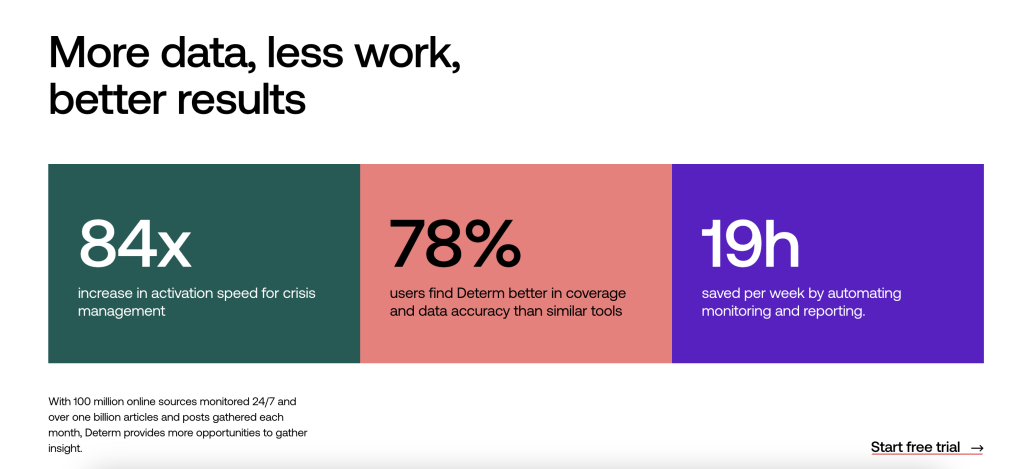A brand audit is like a health check-up for your business – prevention is better than cure.
You should monitor your brand’s health regularly. Conducting a brand audit is a great way to find out what’s working in your business and what’s not. If you are wondering how you can reach more customers or drive more sales, a brand audit might be the thing that you need.
? Read Brand Reputation 101: Monitoring, Analysis, and Management Tools
There are plenty of external companies that you can hire to handle this job. However, we know a more cost-effective way that we’ll show you right now.
Let’s get started.
What Is a Brand Audit and Why does It Matter?
A brand audit provides you with an accurate insight into a brand’s performance on the market. The main purpose of such evaluation is simple: to gain a fundamental understanding of where your brand stands and how it operates against competitors.
In general, every brand has its own life cycle that can be divided into four stages:
- ? Introduction – the moment the brand is launched onto the market
- ? Growth
- ⭐️ Maturity
- ? Decline – until it disappears from the market
Typically, companies face the biggest challenges when they reach the maturity stage. How to stay relevant and a market leader when new brands come along?
And here is the answer: a brand audit lets you monitor the whole cycle so you can keep your brand fresh and respond quickly to any friction.
That’s not all. Why should you conduct brand audits right away?
- Discover brand issues and solutions to resolve them
- Receive honest and unbiased feedback so you can fully understand your brand’s perception
- Identify weaknesses and areas where your brand needs to focus
- Recognize positive and negative aspects of your customer service
- Assess how customers differentiate your brand from competitors

A brand audit is crucial to maximizing your business potential. How to manage it correctly to gain actionable insights into future growth opportunities? You can perform a brand audit quickly and easily.
Let’s look at six steps for strengthening your brand by conducting a brand audit.
How to Conduct a Brand Audit
Step 1 – Determine your goals and priorities
One of the most critical parts of a brand audit that you should start with is reviewing your brand against your business and marketing objectives. You need to know what exactly you hope to achieve.
To determine the purpose of your brand audit, you will need to set your goals and prioritize the most important ones for your business.
No matter what you want to achieve, it helps to establish SMART goals that are Specific, Measurable, Achievable, Relevant, and Time-based. In other words, goals that are very clear and easily understood.
Your expectations should not be too high. Is the result going to be worth the investment? It’s essential to set a goal that is worth your time and energy.
By setting goals, you will be able to prioritize better. Determining priorities will help you avoid getting overwhelmed if you have several goals to achieve, and help you choose the ones your brand needs to focus on from the very beginning.
Divide your goals into top, high, and low priority issues. Determine which ones you will achieve quickly and which will have the greatest returns on investment. Conducting a brand audit will become much simpler once you have done this.
Step 2 – Interview your customers
Brand evaluation cannot take place without customers. Their opinions and feedback should guide your actions. Listen to what they have to say about your brand and try to understand their experiences. Their voices are essential for identifying any gaps between current and desired perceptions.
Get to know your customers and what they think of your brand and competitors. Make sure you understand what your customers like and what they don’t about your main competitors, and do not repeat their mistakes.
You can improve your research by including a group of partners and influencers. Like your customers, they are in direct contact with your brand and may spot something that you have overlooked. Those who have heard about your brand but aren’t your clients can also come into account. Get to know why they didn’t choose your brand.
Keeping up with other opinions about your brand will help you stay a step ahead of your competitors. Check out such areas as their:
- Website
- Pricing
- Delivery
- Product quality
- Social media channels
- Customer support
- Facilities
- Loyalty programs or discounts
- And more.
In addition to assessing your brand strategy and marketing communication, this information helps you determine if you need to make any changes.
Tip! Which metric should you use to measure your customer loyalty and satisfaction? Use the NPS (Net Promoter Score), a metric that measures how likely your customers are to recommend your products or services to others on a scale of 0-10. Then, you can categorize them as Detractors (0-6), Passives (7-8), or Promoters (9-10).
Step 3 – Review what’s being said about you
You can ask a huge number of questions, but to uncover your customers’ real feelings and better understand their emotions, you need to go one step further and analyze what they are saying about you.
With sentiment analysis, you can get an overview of public opinion towards your brand, product, or a specific campaign. Social listening is a crucial component of audience research. It allows you to respond to discussions taking place about you online and build better relationships with customers.
Tip! The process of gathering mentions manually can be extremely time-consuming and take a lot of effort. Not to mention the fact that you won’t be able to “scan” the whole of the Internet. Use a social media monitoring tool like Determ to track online mentions in real-time and react quickly if and when something unexpected occurs.
Software systems such as Determ can tell you about every article, comment, or hashtag that mentions your brand. You will be able to follow any keywords and phrases that are influential for you.
How can Determ help you?
Those of you who are wondering what else this tool can do to help you carry ou better brand audits, here’s a quick look at its capabilities:
- Notifying you of any mention you previously defined by setting keywords
- Automatically categorizing mentions based on their positive, neutral, or negative sentiments in order to understand emotions better
- Using filters to exclude information you aren’t interested in following (this will increase its effectiveness since you won’t waste time on irrelevant mentions)
- Keeping an eye on what your competitors are saying
- Creating reports and exporting them in a minute
Never before has social listening been so easy. Sounds convenient, doesn’t it? As a result, you will be able to listen to your customers better and gain valuable insights for the future.
Step 4 – Investigate the competition
Competitive analysis as a part of a brand audit will help you improve your marketing activities, identify opportunities, and turn the weaknesses of your competitors to your advantage so that you can increase your market share.
By evaluating your brand audit, you can determine where you stand in comparison to other brands on the market. However, to be able to find this out, you need to make a thorough investigation of your competitors.
As in the previous point, it’s definitely a good idea to use social listening to keep an eye on what people say about them. It would be best to look at your biggest competitors’ ads, websites, social media profiles, and customer support in order to get a complete picture of their activities. Keep track of their SEO strategies and the keywords they rank for too. Stay up-to-date, and don’t fall behind.
Step 5 – Compare your intentions with what’s being said about you
After you’ve gotten a glimpse into what your customers are thinking and saying about your brand, you can compare this information with your plans. What has been the reception to your intentions?
A brand audit will show you if there is any tension between how people perceive your brand and what you intend to accomplish. If there is, it could mean that your actions are going in the wrong direction or you have misjudged your target audience and your communication fails to reach them.
As a result of the information you’ve gathered, reevaluate which aspects of your brand need some tweaking, which ones work, and which should be tossed out altogether. This data will enable you to develop an action plan for updating your brand to align it with your business’s mission and goals.
Step 6 – Make conclusions and act on them
After you complete each step of your brand audit and gather all of the necessary data, you will be ready to make final brand audit reviews. Get a better sense of your data by visualizing it. After performing a brand audit, think about all the lessons you have learned and try to implement them.
Verify whether or not the changes made are having the desired effect. Whenever you take action in a particular area, monitor the progress and results then make some adjustments if necessary. All of your decisions and solutions should be made based on the analysis you’ve conducted.
This is the moment when you will be able to see all your brand’s strengths and weaknesses. It’s also a good time to perform a SWOT analysis.
Strengths: positive internal factors that should be taken care of in order to maintain them in the future
Weaknesses: negative internal factors that should be eliminated so that they do not weaken the strengths
Opportunities: positive external events that can be used for development
Threats: negative external events that can block the development of a company
Remember that there are many new brands and trends appearing in a constantly changing market, so performing a brand audit frequently is crucial if you want to stay current. It’s not enough to make a brand audit only once.
The best course of action is to treat a brand analysis as a critical component of your business analysis and repeat it periodically, e.g., once a year or once a quarter.
To Sum Up on Brand Audit
As you can see, a brand audit doesn’t have to be a difficult or expensive process. All you have to do is follow these simple steps to obtain the data you need so that you can make any necessary improvements (Determ will be handy here too).
What will you get in return? Genuine assistance with planning your brand’s development towards strengthening its image and market position.




